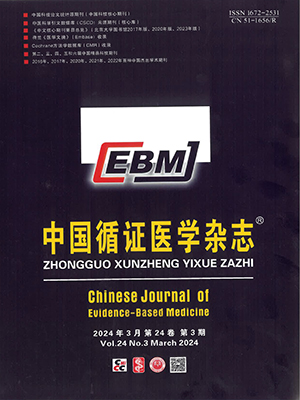| 1. |
Torre LA, Bray F, Siegel RL, et al. Global cancer statistics, 2012. CA Cancer J Clin, 2015, 65(2):87-108.
|
| 2. |
Allott EH, Masko EM, Freedland SJ. Obesity and prostate cancer:weighing the evidence. Eur Urol, 2013, 63(5):800-809.
|
| 3. |
王行环, 瞿利军. 前列腺癌早期诊断进展. 临床外科杂志, 2006, 14(2):79-81.
|
| 4. |
刘修恒. 前列腺癌的早期诊断. 临床泌尿外科杂志, 2007, 22(7):482-485.
|
| 5. |
Hodson R. Prostate cancer:4 big questions. Nature, 2015, 528(7582):S137.
|
| 6. |
曾宪涛, 冷卫东, 郭毅, 等. Meta分析系列之一:Meta分析的类型. 中国循证心血管医学杂志, 2012, 4(1):3-5.
|
| 7. |
Li S, Kwong JS, Zeng XT, et al. Plasmakinetic resection technology for the treatment of benign prostatic hyperplasia:evidence from a systematic review and meta-analysis. Sci Rep, 2015, 5:12002.
|
| 8. |
曾宪涛, 刘慧, 陈曦, 等. Meta分析系列之四:观察性研究的质量评价工具. 中国循证心血管医学杂志, 2012, 4(4):297-299.
|
| 9. |
Zeng X, Zhang Y, Kwong JS, et al. The methodological quality assessment tools for preclinical and clinical studies, systematic review and meta-analysis, and clinical practice guideline:a systematic review. J Evid Based Med, 2015, 8(1):2-10.
|
| 10. |
曾少波, 阮晓岚, 翁鸿, 等. p63蛋白表达与非小细胞肺癌风险相关性的Meta分析. 湖北医药学院学报, 2015, 34(4):371-376.
|
| 11. |
Higgins J, Thompson S. Quantifying heterogeneity in a meta-analysis. Stat Med, 2002, 21(11):1539-1559.
|
| 12. |
黄啸, 周利群, 艾军魁, 等. 前列腺癌E和N型钙粘附素的表达及意义. 癌症, 2002, 21(11):1208-1211.
|
| 13. |
戚晓平, 钱斌, 林考兴, 等. 前列腺癌组织中ILK和E-Cadherin的表达及其意义. 实用癌症杂志, 2004, 19(5):478-480.
|
| 14. |
姚青, 穆红, 张建民, 等. 前列腺病变中E-cadherin、p16和ER表达及意义. 临床与实验病理学杂志, 2004, 20(6):698-701.
|
| 15. |
谷化平, 尚培中, 周翠玲. CD44v6和E-上皮钙黏附素在前列腺癌组织中的表达与癌转移的关系. 中华男科学杂志, 2004, 10(1):32-34.
|
| 16. |
阎利, 戚晓平, 林孝兴, 等. E-cadherin蛋白在前列腺癌组织中的表达及临床意义. 临床军医杂志, 2004, 23(2):32-34.
|
| 17. |
何全中. COX-2和E-cadherin在前列腺癌中的表达与意义. 新乡:新乡医学院, 2006.
|
| 18. |
张锡流, 何仕远, 张力, 等. E-钙黏附蛋白及其相关蛋白在前列腺癌组织中的表达及其临床意义. 检验医学, 2006, 21(1):5-7.
|
| 19. |
朱煊. 前列腺癌中E钙粘连蛋白和环氧化酶2表达的免疫组化研究. 长沙:中南大学, 2007.
|
| 20. |
孙明, 潘春雨, 刘学锋, 等. S100A4蛋白和E-cadherin蛋白在前列腺癌中的表达及临床意义. 现代肿瘤医学, 2009, 17(10):1921-1924.
|
| 21. |
侯铸, 罗勇, 赵佳晖, 等. EMT标记蛋白在前列腺癌组织中的表达及其意义. 中国男科学杂志, 2009, 23(12):21-24.
|
| 22. |
王霞, 章明放, 张玉洁. 钙黏附蛋白及降钙素在前列腺癌组织中的表达及意义. 山东医药, 2010, 50(43):34-36.
|
| 23. |
高双友, 宋蕊, 李双利, 等. E-cadherin及sE-cadherin在42例前列腺癌中的表达及意义. 重庆医学, 2010, 39(23):3240-3241.
|
| 24. |
冀楠. Snail、Slug、E-cadherin在前列腺癌中的表达及其意义. 武汉:武汉科技大学, 2011.
|
| 25. |
毛洲洲. Survivin和E-Cadherin在前列腺癌中的表达及意义. 湛江:广东医学院, 2011.
|
| 26. |
胡祥坤, 程帆, 阮远, 等. p130Cas和E-cadherin在前列腺癌组织中的表达及其临床意义. 中华实验外科杂志, 2011, 28(12):2055-2056.
|
| 27. |
姜涛, 姜辉, 苏晓明, 等. E-cd和α-Cat表达与前深腺组织良恶性和转移性关系的研究. 中华男科学杂志, 2012, 18(6):499-503.
|
| 28. |
王翔. E-cadherin、TGF-β1及Twist在前列腺癌中的表达及意义. 济南:山东大学, 2013.
|
| 29. |
温爽, 盖宇, 宗华凤, 等. 前列腺癌组织P504S、E-Cadherin和bcl-2蛋白表达及意义. 大连医科大学学报, 2013, 35(2):25-28.
|
| 30. |
郭宏涛. E-cadherin和N-cadherin在前列腺癌中的表达及意义. 兰州:兰州大学, 2014.
|
| 31. |
刘祎, 陈先国, 梁朝朝. 前列腺癌肿瘤组织中E-cadherin和N-cadherin的表达及意义. 中华男科学杂志, 2014, 20(9):781-786.
|
| 32. |
韩丽媛, 王伟, 王慧萍, 等. 前列腺癌组织中p53、bcl-2和E-cadherin蛋白的表达水平及临床意义. 生殖医学杂志, 2015, 24(10):845-849.
|
| 33. |
Masterson J, O'Dea S. Posttranslational truncation of E-cadherin and significance for tumour progression. Cells Tissues Organs, 2007, 185(1-3):175-179.
|
| 34. |
Halbleib JM, Nelson WJ. Cadherins in development:cell adhesion, sorting, and tissue morphogenesis. Genes Dev, 2006, 20(23):3199-3214.
|
| 35. |
石珍亮, 张逊. E-cadherin黏附系统及其与肿瘤侵袭转移的关系. 天津医药, 2008, 36(6):476-478.
|
| 36. |
Gould RB, Bracken MB. E-cadherin immunohistochemical expression as a prognostic factor in infiltrating ductal carcinoma of the breast:a systematic review and meta-analysis. Breast Cancer Res Treat, 2006, 100(2):139-148.
|
| 37. |
那彦群, 叶章群, 孙颖浩, 等. 中国临床泌尿外科疾病诊断治疗指南. 北京:人民卫生出版社, 2013.
|




